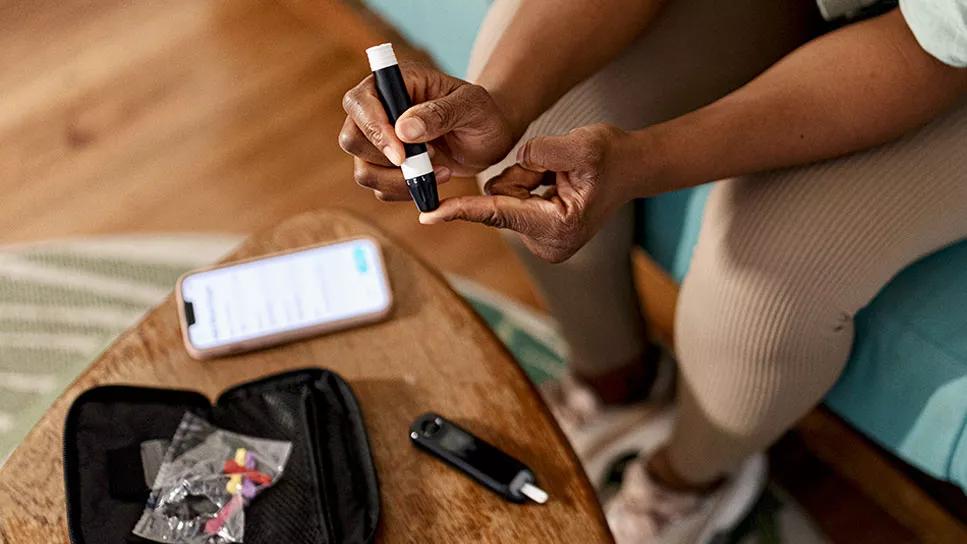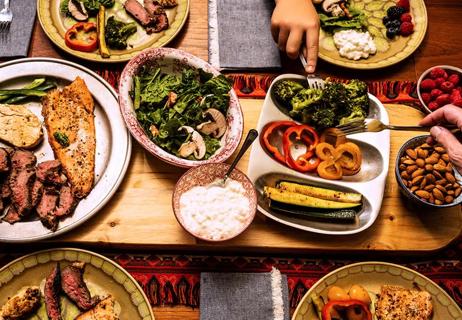Type 1 diabetes happens when your body doesn’t make insulin, while Type 2 happens when your body can’t use insulin properly

The U.S. Centers for Disease Control and Prevention (CDC) estimates that about 1 in 10 people in the United States is living with diabetes.
Advertisement
Cleveland Clinic is a non-profit academic medical center. Advertising on our site helps support our mission. We do not endorse non-Cleveland Clinic products or services. Policy
And that’s not including the 98 million people in the U.S. who have prediabetes — elevated glucose levels (aka blood sugar) that don’t quite hit the threshold for diabetes.
The vast majority of people with diabetes — more than 90% of them — are living with Type 2 diabetes. But there are other kinds, too. And they’re easily confused. Especially when talking about the differences between Type 1 and Type 2 diabetes, myths and inaccuracies abound.
We talked with certified diabetes care and education specialist Shannon Knapp, MEd, BSN, RN, CDCES, about the differences between Type 1 and Type 2 diabetes, why they happen and how to best manage your life with the conditions.
Diabetes is one of the most common chronic conditions in the U.S.
But what is diabetes exactly?
It starts with insulin, a hormone made in your pancreas that helps your body use glucose (sugar).
“Glucose is a good thing to have in our body, but it has to get into our body’s cells in order to give us energy,” Knapps explains. “Glucose starts in the bloodstream, and insulin acts as a key that unlocks the doors of the cells. It allows glucose to get out of our bloodstream and into our cells.”
People with diabetes fall into one of two camps:
Advertisement
Whether your body makes insulin is one of the main differences between Type 1 and Type 2 diabetes.
We’ll get into the details in a bit, but here’s a quick look:
| Type 1 diabetes | Type 2 diabetes | |
|---|---|---|
| How common is it? | Affects about 1.3 million people in the U.S. | Affects about 37 million people in the U.S. |
| Why does it happen? | Autoimmune condition | Hormonal condition |
| Does your body make insulin? | No. | Yes, at least at first. But your body doesn’t respond to it |
| Do you need to take insulin? | Yes. | Sometimes. |
| Can it affect kids? | Yes. Often as young as 4 to 6 years old. | Yes. It’s more likely in adults, but becoming more common in kids and teens. |
| How common is it? | ||
| Type 1 diabetes | ||
| Affects about 1.3 million people in the U.S. | ||
| Type 2 diabetes | ||
| Affects about 37 million people in the U.S. | ||
| Why does it happen? | ||
| Type 1 diabetes | ||
| Autoimmune condition | ||
| Type 2 diabetes | ||
| Hormonal condition | ||
| Does your body make insulin? | ||
| Type 1 diabetes | ||
| No. | ||
| Type 2 diabetes | ||
| Yes, at least at first. But your body doesn’t respond to it | ||
| Do you need to take insulin? | ||
| Type 1 diabetes | ||
| Yes. | ||
| Type 2 diabetes | ||
| Sometimes. | ||
| Can it affect kids? | ||
| Type 1 diabetes | ||
| Yes. Often as young as 4 to 6 years old. | ||
| Type 2 diabetes | ||
| Yes. It’s more likely in adults, but becoming more common in kids and teens. |
Type 1 diabetes is an autoimmune disorder. That means it’s caused by an overactive immune system.
When you have Type 1 diabetes, your body doesn’t produce insulin. That’s because your immune system mistakes cells in your pancreas for invaders. Your immune system attacks your insulin-making cells, destroying your natural ability to produce insulin.
People with Type 2 diabetes do make insulin — at least at first. But their bodies don’t use it properly. It’s called insulin resistance. It happens when the cells in your muscles, liver and fat stop responding to insulin.
Going back to Knapp’s analogy of insulin as a key to the doors of your cells: Type 2 diabetes is like having the key to the house, but the lock is sticky. You jiggle the key a few times. You pull the key out and put it back in over and over. Eventually, you give up on using the key. You knock on the door and hope someone is home to answer.
The same thing happens in your pancreas when you have insulin resistance.
In the early stages of insulin resistance, your pancreas goes into overdrive trying to make more insulin. That’s called hyperinsulinemia. It’s making more keys, trying to get them to work. But eventually, it can give up and toss the keys to the side.
“As time goes by for people with Type 2 diabetes, their pancreas will generally make less and less insulin because it’s not being effective anyway,” Knapp explains. “Eventually, it may not make any insulin at all.”
Diabetes is a life-long condition. That goes for both Type 1 and Type 2. And there are some differences in the way the conditions are managed.
People with Type 1 diabetes must take synthetic insulin medication. Their bodies don’t make it, and they can’t stay healthy without it.
Some people with Type 2 diabetes take synthetic insulin if their bodies have stopped producing insulin on their own or if they need more.
“It’s not unusual for people with Type 2 diabetes to take insulin at some point because their pancreas stops making enough,” Knapp confirms.
Insulin is often taken one or more times each day by injecting it with a syringe or an insulin pen. It can also be taken continuously with the help of an insulin pump. There’s even an inhaled form of insulin.
Advertisement
People with Type 2 also may take other medications to help manage their condition. Some medications encourage their pancreas to make more insulin. Others work by encouraging their liver to release less glucose. And some can help their cells to use insulin better.
These medications may be used with or without insulin depending on your needs.
Both Type 1 and Type 2 diabetes require some lifestyle changes.
In both conditions, maintaining a healthy glucose level is important.
One way people do this is with glucose monitoring devices, like glucose sticks, finger sticks or continuous glucose monitors.
And eating a healthy diet is critical for anyone with diabetes. Knapp advises that people with diabetes focus on eating lean proteins, nonstarchy vegetables, healthy fats and complex carbohydrates
“What you eat will affect your glucose levels, regardless of what type of diabetes you have,” she adds. “Healthy meal planning is important for everyone, whether they have diabetes or not. But people with diabetes are striving for a balance between what they eat and all the other things that impact their glucose level, like activity and insulin or other medications.”
Stress management is also key for people with diabetes. According to Knapp, “Hormones released during our stress response can raise our heart rates, blood pressure and glucose levels. Stress and emotional responses also make it more difficult to eat right, exercise and take care of yourself, which makes it harder to manage diabetes. So, stress management matters a lot.”
Advertisement
Some people think of Type 1 diabetes as a progression of Type 2 diabetes. But that’s not the case.
Remember that the causes of Type 1 and Type 2 diabetes are different. If you have an autoimmune condition that keeps you from making inulin, you have Type 1 diabetes. If you have insulin resistance, that’s Type 2 diabetes.
“It’s a common misconception that if you take insulin, you must have Type 1 diabetes, but that’s not the case,” Knapp clarifies. “People take insulin when their bodies don’t produce insulin or don’t produce enough insulin. Taking insulin isn’t an indication of what type of diabetes you have.”
Advertisement
Learn more about our editorial process.
Advertisement

Opt for foods that have a mix of protein, fiber and healthy fats

Pack extra medication and supplies, bring healthy snacks and set reminders

Use the ‘plate method’ to create a meal with non-starchy vegetables, lean proteins and carbs

Keto can reduce blood sugar, but that doesn’t mean it’s right for everyone

This diabetes medication can treat obesity, but it’s not for people who just want to drop a few pounds

If you have diabetes, working out soon after eating can help lower your blood sugar

Taking a smaller dose than what your doctor recommends isn’t a good idea

Hot, humid weather can affect your blood sugar levels and even cause dehydration or heat stroke

The best parenting style balances enforcing rules and showing plenty of love

Tips include cutting back on sugar, focusing on exercise and managing stress

It can be harder to let go when you’ve invested time, energy and emotions — but it might be the healthier choice long term